
A true toad is any member of the family Bufonidae, in the order Anura. This is the only family of anurans in which all members are known as toads, although some may be called frogs. The bufonids now comprise more than 35 genera, Bufo being the best known.

Adenomus is a small genus of true toads, with only two species, endemic to Sri Lanka. Adenomus kandianus was considered as extinct for 133 years, but was rediscovered in October 2009 in the Kandy area.

The Carchi Andes toad is a species of toad endemic to the western slopes of the Andes in northern Ecuador and southern Colombia. It is listed as an endangered species due to a restricted range and habitat loss.
Rhaebo olallai is a species of toad in the family Bufonidae endemic to Ecuador. Its common name is Tandayapa Andes toad, after its type locality, Tandayapa, in the Pichincha Province); the species has not been seen there after 1970, despite search efforts. It is only known from another locality in the Imbabura Province of Ecuador. It has also been reported from one locality on the Colombian Massif, Nariño Department, Colombia, but these have been shown to represent Rhaebo colomai.
Blomberg's toad, also known as the Colombian giant toad, is a very large species of toad in the family Bufonidae. It is found in rainforests at altitudes between 200 and 650 metres in western Colombia and northwestern Ecuador. It has been recorded in Florida in 1963, apparently because of pet escape or release, but did not get established.

Rhaebo caeruleostictus is a species of toad in the family Bufonidae. It is endemic to Ecuador and occurs along the lower western slope of the Cordillera Occidental at elevations of 40–2,000 m (130–6,560 ft) asl. The specific name caeruleostictus, from Latin caeruleus (=blue) and Greek stiktos (spotted), refers to the bluish colour pattern of this species. Accordingly, common name blue-spotted toad has been coined for it.
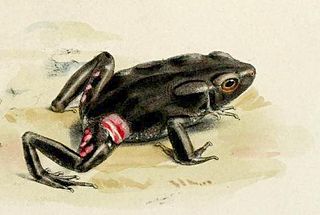
Rhaebo glaberrimus is a species of toad in the family Bufonidae. Its common name is Cundinamarca toad, after its type locality, "Bogota", Cundinamarca, although this location is likely to be incorrectly reported. It is found in eastern Amazonian Colombia, including the lower eastern slopes of the Cordillera Oriental to 1,470 m (4,820 ft) asl, and adjacent Venezuela. Rhaebo ecuadorensis from Ecuador and Peru was formerly confused with this species. It has also been confused with Rhaebo guttatus.

The smooth-sided toad or spotted toad, formerly known as Bufo guttatus, is a species of toad in the family Bufonidae. It is found in the Amazonian Bolivia, Brazil, Colombia, Ecuador, Peru, and Venezuela, as well as the Guianas. Specimens from southern Peru, Bolivia, and Brazil might represent Rhaebo ecuadorensis described in 2012.
Werner's toad is a species of toad in the family Bufonidae. It is found in northwestern Guyana and eastern Venezuela at elevations of 500–1,350 m (1,640–4,430 ft) asl.
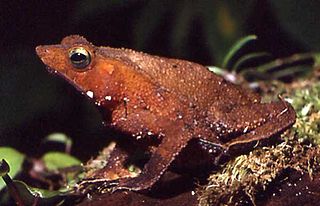
Rhinella proboscidea is a species of small South American toad in the family Bufonidae, common in the Amazon rainforest. It is the only species known to practice reproductive necrophilia.
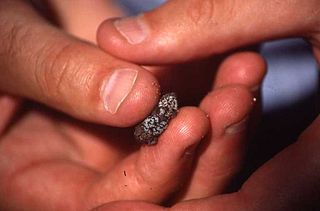
Mertensophryne is a genus of true toads. They are found in eastern and southern Democratic Republic of Congo to Kenya, Tanzania, Malawi, southeastern Zimbabwe, and adjacent Mozambique. Their common names include snouted frogs, Chirinda forest toads, and forest toads. The genus is named for Robert Mertens, German zoologist and herpetologist.

Sclerophrys is a genus of "true toads", family Bufonidae, native to Africa and the southern Arabian Peninsula. Originally, all of these species were classified in the genus Bufo. The genus, originally named Amietophrynus, was split due to large enough taxonomic divergence. Ohler and Dubois showed in 2016 that Sclerophrys capensis Tschudi, 1838 is the same species as Bufo regularis rangeri Hewitt, 1935, the type species of Amietophrynus. Because the former name is older, the implication is that Amietophrynus is a junior synonym of Sclerophrys.

Incilius is genus of toads in the true toad family, Bufonidae. They are sometimes known as the Central American toads or Middle American toads and are found in southern USA, Mexico, Central America, and northern Pacific South America. They are an ecologically and biogeographically diverse group of toads, including micro-endemic species such as Incilius spiculatus that are restricted to undisturbed cloud forests, and widespread lowland species such as Incilius valliceps that predominantly occur in disturbed habitats.

Poyntonophrynus, also known as pygmy toads, are a genus consisting of ten true toad species native to Sub-Saharan Africa. Originally, all Poyntonophrynus species were included in the genus Bufo. The genus was split due to large enough taxonomic divergence as evidenced by molecular markers. The genus is named in honour of John C. Poynton, South African herpetologist, with phrynus being Greek for toad.
Nannophryne is a small genus of true toads, family Bufonidae, from South America. They are found in central Andean Peru south to southern Chile and adjacent Argentina.
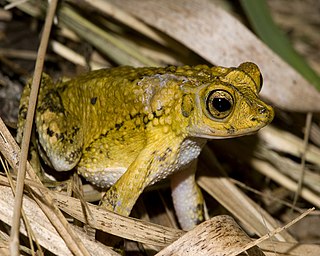
Peltophryne is a genus of true toads in the family Bufonidae, from the Greater Antilles. With ten endemic species, Cuba hosts the highest diversity. Hispaniola has three endemics and Puerto Rico and the Virgin Islands combined has one.

Phrynoidis is a small genus of true toads, family Bufonidae. They are found in Mainland Southeast Asia and the Greater Sundas. They are sometimes known as the rough toads or river toads.
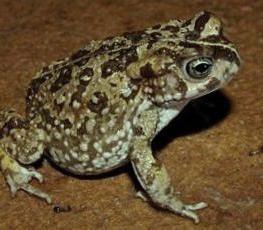
Vandijkophrynus, also known as Van Dijk's toads, are a small genus of true toads, family Bufonidae. They are native to Southern Africa. The name commemorates Eddie Van Dijk, a South African herpetologist.
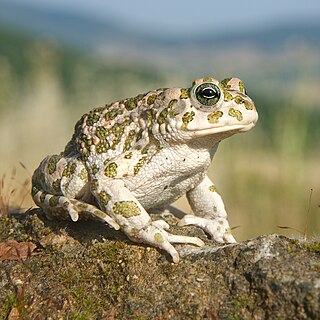
Bufotes, the Eurasian green toads or Palearctic green toads, is a genus of true toads. They are native to Europe, western and central Asia and northern Africa; a region roughly equalling the western and central Palearctic. Historically they were included in the genus Bufo and then for a few years placed in Pseudepidalea, which is a synonym of the currently accepted name Bufotes.















